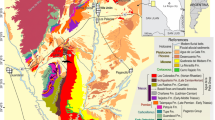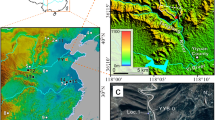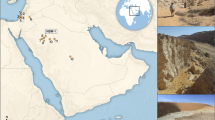Abstract
The archaeological site at Tata, 70 km WNW of Budapest, has yielded a Mousterian lithic industry of small artefacts chipped from chert pebbles, with affinity to the Quina type1. However, the two best known artefacts from the site are a ‘churinga’ carved from a piece of a mammoth tooth (Fig. 1), and an amulet with an inscribed cross, made on a polished nummulite fossil. Marshack (personal communication), who examined both the churinga and nummulite, observed that one or both arms of the cross ‘engraved’ on the nummulite are in fact natural fractures that penetrate through the stone. However, the ivory plaque appears to have been carefully separated from a compound molar tooth of a mammoth, shaped and bevelled, and then coloured red by rubbing with ochre. The age of this site was first determined by 14C analysis of charcoal from the cultural layer2. The age of 55±2.5 kyr led Bordes to assign the cultural material to the middle Mousterian. However, palaeontological data3 indicate that this site was occupied towards the end of the last interglacial. Also, two single determinations of Th/U ages on travertines from the site yielded dates of 116±16 kyr(ref. 4) and 70±20 kyr (ref. 5), both of which are more consistent with present estimates of the time interval corresponding to the last interglacial (125–90 kyr). We report here new uranium series dates on the travertine which show that the site was occupied at ∼100 kyr BP. This confirms that the amulet from this site is one of the oldest decorative artefacts known, and was presumably created by Homo sapiens neanderthalensis.
This is a preview of subscription content, access via your institution
Access options
Subscribe to this journal
Receive 51 print issues and online access
$199.00 per year
only $3.90 per issue
Buy this article
- Purchase on Springer Link
- Instant access to full article PDF
Prices may be subject to local taxes which are calculated during checkout
Similar content being viewed by others
References
Bordes, F. The Old Stone Age, 110 (New York, McGraw Hill, 1972).
de Vries, H. & de Waard, H. Arch. Hungarica 43, 35–36 (1964).
Kretzoi, M. Arch. Hungarica 43, 105–128 (1964).
Cherdyntsev, V., Kazachevskii, I. V. & Kuzmina, E. A. Geochem. Int. 2, 794–801 (1965).
Pecsi, M. Földr. Közl 2, 109–119 (1973).
Schwarcz, H. P. Archaeometry 22, 3–24 (1980).
Szabo, B. J., Carr, W. J. & Gottschall, W. C. U.S. Geol. Survey, Open-File Rep 81–119 (1981).
Vértes, L. Arch. Hungarica 43, 133–249 (1964).
Kretzoi, M. & Vértes, L. Arch. Hungarica 43, 251–256 (1964).
Shackleton, N. & Opdyke, N. J. Geol. Soc. Am. Mem. 145, 449–464 (1976).
Schwarcz, H. & Debénath, A. C. r. hebd. Acad. Sci., Paris 288, 1155–1157 (1979).
Author information
Authors and Affiliations
Rights and permissions
About this article
Cite this article
Schwarcz, H., Skoflek, I. New dates for the Tata, Hungary archaeological site. Nature 295, 590–591 (1982). https://doi.org/10.1038/295590a0
Received:
Accepted:
Issue Date:
DOI: https://doi.org/10.1038/295590a0
This article is cited by
-
Incision of a river curvature due to exhumed Miocene volcanic landforms: Danube Bend, Hungary
International Journal of Earth Sciences (2006)
-
Chronology of the major palaeohydrological events in NW Africa during the late Quaternary: PALHYDAF results
Hydrobiologia (1991)
-
Middle pleistocene adaptations in Central Europe
Journal of World Prehistory (1989)
-
Early man: A new chronology for the Mousterian
Nature (1983)
Comments
By submitting a comment you agree to abide by our Terms and Community Guidelines. If you find something abusive or that does not comply with our terms or guidelines please flag it as inappropriate.



